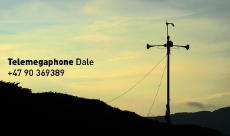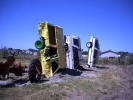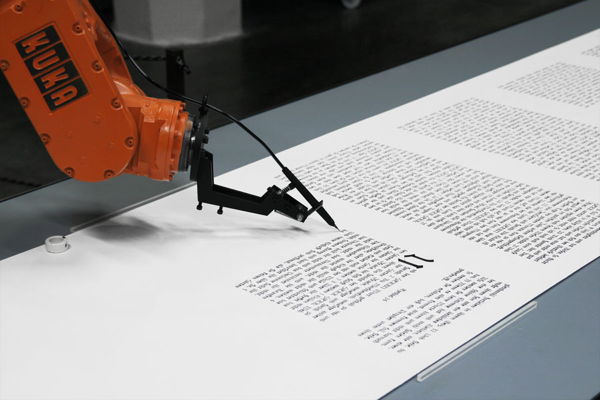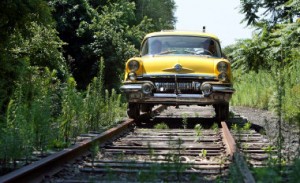Technology
Telemegaphone Dale

When you dial the Telemegaphone’s phone number the sound of your voice is projected out across the fjord, the valley and the village of Dale below.
I wonder how many collect calls it receives?
Posted By: Alex - Fri Aug 08, 2008 -
Comments (1)
Category: Buildings and Other Structures, Technology
Robotic and Redneck Stonehenge
Steve Norris has built a Stonehenge Robotic Digital Clock. I don't think it would work so well as a bedside timepiece (the whirring of it might keep you up at night), but it would definitely be something you could show off to your friends. It would be even cooler if a version of this were built that was the actual size of Stonehenge. (via OhGizmo!)
Posted By: Alex - Tue Aug 05, 2008 -
Comments (0)
Category: Buildings and Other Structures, Inventions, Technology, Video
Riding the Rails
Of course we all know that the image of a hand-pumped railroad trolley is a comedy staple. But I find the notion of special little motorized vehicles adapted to ride the rails just as funny. As you might predict, there's an organization dedicated to hobbyists and collectors of these miniature rail-mounted transports, and it's to be found here.My local newspaper has a great article about a fellow who restored the vehicle pictured to the right.
I imagine a Farelly Brothers movie in which the hero confounds the bad guys by making his unpredictable escape in such a vehicle--at a whopping 5 MPH!
Posted By: Paul - Mon Aug 04, 2008 -
Comments (2)
Category: Eccentrics, Collectors, History, Inventions, Technology, Travel, Transportation, 1950s, Cars
Gamucci Electronic Cigarettes

So basically it's a miniaturized fog gun that you hold in your mouth. Sounds like a swell way to join the revolution!
Posted By: Alex - Tue Jul 29, 2008 -
Comments (3)
Category: Technology, Products
Jetpack Dreams
That most silly and pointless and inutile, yet much desired of flight mechanisms, the jetpack, is back in the news. You can read a New York Times piece about the latest model here.And a review copy of this book recently arrived in my mailbox, portending lots of fun.
Yet such mechanisms pale before the magnificently insane accomplishment of Yves Rossy, who, a couple of years ago, basically turned himself into Iron Man. Watch his jet-powered flight below.
Posted By: Paul - Tue Jul 29, 2008 -
Comments (4)
Category: Eccentrics, Flight, Inventions, Literature, Science Fiction, Movies, Obsessions, Pop Culture, Technology, Travel, Yesterday’s Tomorrows
Robotic Writing Monk
The relentless march of progress continues. Now monks have been automated, thanks to The Bible Scribe.Start looking for a new job, Brother.

Posted By: Alex - Wed Jul 23, 2008 -
Comments (0)
Category: Art, Religion, Technology, AI, Robots and Other Automatons, Books
The Cow Whisperer
I suspect cows are going to become a theme here at WU. They're ubiquitous and silly and important. Those are three good criteria for inclusion here. Hey, if cows were good enough for Gary Larson humor, they're good enough for us!The latest news is that they're demanding headphones as they graze! Not sure if iPods are included. Read the article here.
Then watch the video of "The Cow Whisperer" here.
Posted By: Paul - Wed Jul 23, 2008 -
Comments (5)
Category: Agriculture, Food, Science, Experiments, Technology, Cows
Looks Like a Robot
The Looks Like A Robot Flickr pool does not contain any photos of robots. What it does contain is over 300 pictures of objects that look like robots. Lots of fun to browse. (Thanks, Bob!)
Posted By: Alex - Wed Jul 23, 2008 -
Comments (0)
Category: Technology
How many megabytes is your brain?

Hitachi recently announced that in 2010 they plan to unveil a 5TB hard drive. This led them to note that, "By 2010, just two disks will suffice to provide the same storage capacity as the human brain."
So, according to Hitachi, the brain has a 10TB storage capacity. But how did they arrive at this number?
There's been a lot of speculation about the brain's storage capacity. The most popular method of arriving at an answer is to estimate the number of synapses in the brain and extrapolate from there. This has led researchers to come up with numbers ranging anywhere from 3TB to 1000TB. Hitachi evidently was using this method.
But there's a second method (noted on the Of Two Minds blog). Psychologists have conducted experiments to measure how much information people are actually able to memorize. This produces much smaller numbers. They've concluded that it's only about two bits per second, or a few hundred megabytes averaged over an entire lifetime.
Of course, until scientists figure out a way to allow us to download our brains to computers, all these numbers are just useless trivia. And when that happens, we can all plug into the Matrix and live happily ever after.
Posted By: Alex - Mon Jul 21, 2008 -
Comments (0)
Category: Science, Psychology, Technology
Mechanical Elephants
Once upon a time, mechanical elephants roamed up and down the boardwalks of beaches. Check out the clip below from a 1950s newsreel. The elephant, built by Frank Stuart was "Gasoline Powered with a 4 cylinder English Side Valve Ford engine. Top speed 27 MPH!"I found the clip on the blog of Eastcliff Richard who reports that, "Astonishingly Britain used to lead the world in the production of mechanical elephants. This one was later sold to the late, great, dearly-departed Peter Sellers as part of his eccentric collection of automobilia."
Some more videos of mechanical elephants can be found here and here.
Posted By: Alex - Thu Jul 17, 2008 -
Comments (1)
Category: Animals, Inventions, Technology

| Who We Are |
|---|
| Alex Boese Alex is the creator and curator of the Museum of Hoaxes. He's also the author of various weird, non-fiction, science-themed books such as Elephants on Acid and Psychedelic Apes. Paul Di Filippo Paul has been paid to put weird ideas into fictional form for over thirty years, in his career as a noted science fiction writer. He has recently begun blogging on many curious topics with three fellow writers at The Inferior 4+1. Contact Us |





